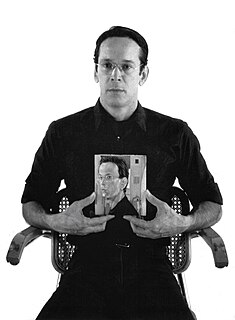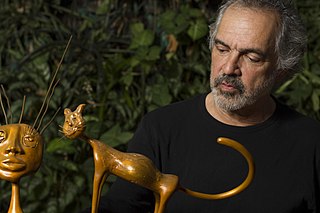Jorge Blanco is a Venezuelan-born American artist, who emigrated to the United States in 1999. He has spent his professional career working as a sculptor, graphic designer and illustrator. His work is in public sites in the United States, South America and Japan. Jorge Blanco is an international artist who has created a sculptural language over more than thirty years. Blanco has placed 25 public art sculptures in large format across the globe. In addition to public art, Blanco continues his life trajectory with collectible sculptures, his comic strip "The Castaway," and furniture design. His artworks form part of sales in auction houses such as Sotheby's and Christie's. In 1971 Blanco graduated as an industrial designer from the Neumann Institute of Design in Caracas, Venezuela. Under the mentorship of European artists living as expatriates in Caracas, Blanco learned to integrate industrial design with creative processes. His instructors were predominantly artists, such as Gego and Cornelis Zitman, who emphasized artistry in their classrooms. Blanco graduated with a degree in industrial design upon the completion of his first furniture line for children, which was a thesis project. Immediately after graduation Blanco began his career as a sculptor, freelance graphic designer and furniture designer. In the late 70s he studied at Rome's Academy of Fine Arts. During his stay in Europe Blanco also uncovered the world of cartoonists. This discovery led Blanco to create the comic strip, "The Castaway." In 1980 "The Castaway" made its debut in El Diario de Caracas. T Castaway was widely disseminated across the city, including the city's metro system. Eight books have been published on Blanco's "The Castaway." As "The Castaway" continued to live its success, Blanco illustrated more than twenty storybooks for children and countless educational books. His accomplishments as illustrator led him to El Museo de los Niños, where he served as Creative Director for twenty years.Like the work of his primary influences, Klee, Miró, Herbin and Calder, Blanco's presents his sculptures in primary colors. Blanco's largest body of work has been created and fabricated in the United States, where he lives and works since 1999. His artwork has received multiple accolades.

Darío Escobar is a Guatemalan artist.
Ramón Antonio Carulla is a Cuban artist.
Mario Algaze is a Cuban-American photographer.
Luis Vega De Castro is a Cuban artist. Since 1980 he has lived in Miami, Florida, United States. He works in graphic design, painting, drawing and illustration, and has been noted for his work in film posters.
Emilio Falero is a Cuban Fine Arts painter residing in Florida.
Rubén Torres Llorca is a Cuban artist specializing in painting, drawing, sculpture, collages, and photography. He studied from 1972 to 1976 at the Escuela Nacional de Bellas Artes "San Alejandro" in Havana and from 1976 to 1981, studied at the Instituto Superior de Arte (ISA), also in Havana. Torres resided in Mexico City, Mexico from 1990 to 1993 and has resided in Miami, Florida, since 1993.

Humberto Calzada is a Cuban-American artist living in Miami, Florida, since 1960.

Manuel Carbonell was a Cuban Contemporary and Modern artist, regarded as among the greatest Cuban sculptors of his generation. He was part of the generation of Cuban artists, which includes Wifredo Lam and Agustín Cárdenas, that studied at the Escuela Nacional de Bellas Artes "San Alejandro", Havana, Cuba. Carbonell's inexhaustible vision and his ever-changing style is the product of a brilliant talent with an academic background. Ceaselessly searching for the essence of form and the absence of details, he empowered a sense of strength and monumentality to his work. Until the age of 92, he had continued to work daily in his studio.

Harry Abend, OFM was a Polish-born Venezuelan sculptor and architect. Abend immigrated to Venezuela in 1948 and embarked on his sculpture practice in 1958 under the guidance of Miguel Arroyo while also studying architecture at the Universidad Central de Venezuela. In 1963, at the age of 26, Abend received the National Sculpture Prize of Venezuela for his work "Forma" 1961. In 1964, he participated in a three-month workshop led by British sculptor Kenneth Armitage. In 1976 Abend moved to London where he continued developing his work and exhibited in galleries such as the Roundhouse Gallery and the Hayward Gallery. Around this time Abend began to receive commissions to stage interventions in urban and architectural environments, such as the cement mural on the façade of the Teatro Teresa Carreño, and the interior design of the Sala Plenaria in the east tower of Parque Central, both in Caracas. A selection of his solo shows include Esculturas, Museo de Arte Moderno, Río de Janeiro (1968); three exhibitions at Sala Mendoza, Caracas ; Electrum Gallery, London (1977); Saint James Piccadilly Festival, London (1981); a retrospective at the Museo de Arte Moderno Jesús Soto, Ciudad Bolívar (2002); Museo de Arte Acarigua Araure, Acarigua (2003); Museo Kern Unión Israelita de Caracas (2012); Galería GBG ARTS, Caracas and Henrique Faria, New York. He lived and worked in Caracas.

Carlos J. Tirado Yepes, is a Venezuelan artist, painter and sculptor who has developed a very personal and precise work line linked to Neo-pop art. With plenty of personal art exhibitions, Tirado Yepes has participated in numerous collective exhibitions, receiving different awards like III Premio de Escultura del Certamen Aires de Córdoba in 2004 and other recognitions, among them, in the Venezuelan Embassy in DC (2005), and the X Latin Art Festival of Atlanta (2005).
Édgar Francisco Jiménez is a Colombian artist.

Muu Blanco, is a multidisciplinary Venezuelan artist. He works in the plastic arts, performance, drawing, photography, electronic music, conceptual video, and handbag design. His compositions have been presented locally as well as internationally, including in cities like: New York City, Berlin, Miami, Barcelona, Bogota, Buenos Aires, London, Vancouver and Milan. His work has been regarded as a criticism to power, wealth and narcissism, as well as commentary on the urban landscape of modern Caracas.
Miguel Ángel Rojas is a Colombian conceptual artist born in Bogotá in 1946. His work includes drawing, painting, photography, installations and video and is often related to the sexuality, the marginal culture, the violence and problems involved with drug consumption and production.
José María Mijares was a Cuban contemporary visual artist. He began drawing in his adolescent years and entered the San Alejandro Academy of Fine Arts on a scholarship at the age of 16. His greatest influences were the artists of the "Havana School": Carlos Enríquez, René Portocarrero, Cundo Bermúdez, as well as his professors, most notable being modernist painter Fidelio Ponce. He was also a part of the influential group, Los Diez Pintores Concretos, or as they are usually referred to, Los Diez. Although the group had a relatively short life, 1959-1961, and exhibited together only a few times, they remain an important part of Cuba's art history especially in the pre-Castro years and leading up to the revolution. He left Cuba in 1968, resigning his teaching position at the academy when Fidel Castro came into power. Based in Miami, he continued to be a prolific painter and until his death in 2004, at the age of 82.

Juan González was an important twentieth century Cuban-American painter who rose to international fame in the 1970s and remained active until his death in the 1990s. Born in Cuba, González launched his art career in South Florida during the early 1970s and quickly gained recognition in New York City, where he subsequently relocated in 1972. While in New York González won several fine art awards, including the National Endowment of the Arts, New York Foundation for the Arts grant, and the Cintas Fellowship. González's art known is for its distinctive hyperrealism and magical realism elements delivered in a highly personal style with symbolic overtones. His work has been widely exhibited throughout the United States as well as internationally in Europe, Latin America, and Japan. He is included in the permanent collections of The Metropolitan Museum of Art, Art Institute of Chicago, The Carnegie Museum of Art, and Hirshhorn Museum and Sculpture Garden.
Elba Damast was a Venezuelan artist.

Abigail Varela is a Venezuelan visual artist. He is best known for bronze sculptures representing pre-Columbian of abstract feminine figures interpreted in modern style in poses that suggest motion.
Gary Nader is an international art collector based in Miami, Florida. Nader focuses on Latin American Art and possesses the largest private Fernando Botero collection in the world. Nader has promoted Latin American artists and has collected their works at the Latin American Art Museum (LAAM) in Miami.

Marta Cazañas Permuy was a Cuban-American fine art patron, art collector, curator, art dealer, and promoter based in Coral Gables, Florida. She was an influential figure in the establishment of the Latin American art market of South Florida. She managed and co-founded Permuy Gallery, one of the first venues dedicated to Cuban art in the United States. She also hosted a long-running art salon where South Florida art, literary, business, and political figures would gather to discuss art and culture.








